Riding the Tides in Baja
Clark June 8th, 2017
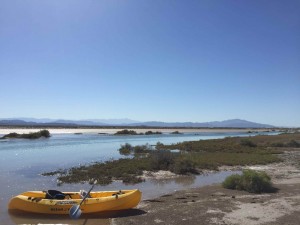
Yes, I like crossing oceans and making great landfalls, but I’m obsessed with the smaller crevices of our watery world.
My mom built a shack on the beach in Baja 35 years ago, and passed it on to me. The shack sits about 20 miles south of San Felipe, near the top of the Gulf of California (Sea of Cortez). The tidal range is over twenty feet. During the highest tides the desert floods, and what is normally dry land becomes accessible by water. It’s very bizarre and heady to paddle a kayak or sail a windsurfer across mud flats and sand dunes that are only navigable for a few hours per year. The rest of the time they are blazing hot, godforsaken desert or salt pan.
I’ve been exploring the estuary off Santa Maria Bay my whole life, as this is where windsurfing was born, and we were always a windsurfing family. Another estuary, Laguna Percibu, lies to the north, and I’ve always surmised that with a very high tide the two estuaries would almost connect. With the advent of Google Maps I didn’t need to surmise anymore, as it shows a very clear picture. At the far right (south) is Santa Maria Bay, with its estuary extending to the left, and to the far left (north) is Laguna Percibu, with its estuary extending to the right. You can see where the two estuaries nearly connect, in the middle of the photo:
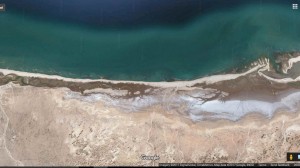
There was a high tide last week, during our vacation, and I set out on my grand adventure. I’ve found over the years that sun protection is key while paddling a sit-on-top kayak in the desert, so I wear a long-sleeved shirt and wide-brimmed hat, but the bare legs, stretched out in front, tend to get scorched, even with a liberal application of sunscreen. Thus, I always put something, like an old towel, over my legs. My adventure was early in our trip, and we didn’t have any dirty towels yet, so I grabbed this apron out of the house, without really thinking about it:
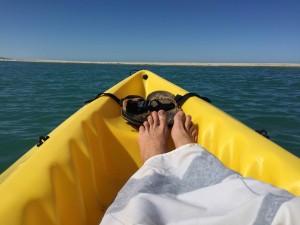
It occurred to me later that it might be considered a little strange, a grown man setting off alone into the desert with his naughty French maid apron:
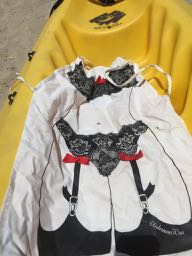
I made efforts to hide it when I neared civilization.
As planned, I rode the rising tide deep into the desert, but soon came upon this dead whale, which is about the strangest, nay impossible, place to find a dead whale:
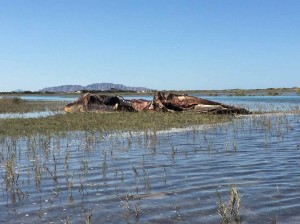
I’d estimate it at 30-35 feet long, maybe a humpback or a gray whale. I was already at nearly the high of a very high tide, and a good mile into a complex maze of an estuary, which makes it nearly impossible for a dead whale to have been beached above me. It must have been the most tragic whale death ever, with the poor thing getting lost in the estuary at the highest of tides, then thrashing its way even higher. Either that or aliens dropped it there.
For the next hour or so I meandered farther up the estuary, so that I’d paddle into the deadly stench slipstream of whale carcass, then back out into the cleanest desert air on earth, then back into the stench again.
Finally I’d paddled as far as I could, and the tide was about as high as it was going to get, so I donned my flip-flops and set out, kayak in tow, in what I thought was the direction of the Percibu estuary. The flip-flops were quickly rendered useless with ten pounds of mud stuck to them, but the mud was soft, not too hot, and there weren’t too many prickly things:
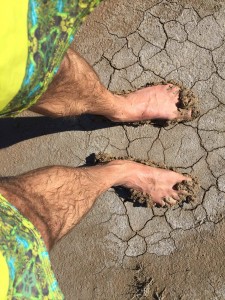
However, the mud was sticky enough that it really gripped the tail end of the kayak, meaning dragging it behind me took a lot of effort. The portage ended up being maybe half a mile with all my wrong turns, zigging and zagging, but I eventually found water on the Percibu side that was deep enough to paddle. Then it wasn’t deep enough, then it was, then it wasn’t, but then it really opened up into a full-on inland sea, and I was on my way north, with the tide falling and a current behind me:
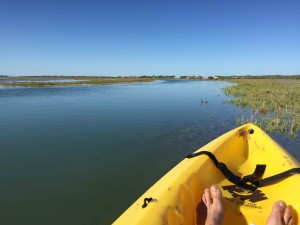
Some mariner who proceeded me wasn’t so lucky, and his descendants came to a very remote place to honor him. In many Catholic countries they believe that where life leaves the body is just as important as where the body is interred, so they maintain a shine at the place of his death, thus so many roadside shrines at the sites of fatal car accidents:
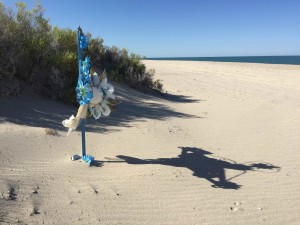
I stopped a few times to stretch my legs, and the views were always grand. Picacho del Diablo, the highest mountain in Baja, was always visible to the west:
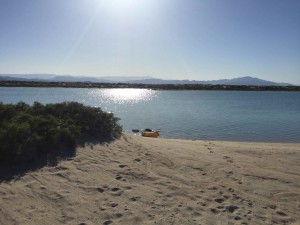
I finally arrived at Laguna Percibu, where there is a normally a very sleepy bar and restaurant, but being Memorial Day Weekend it was thumping with techno music and college kids making out. I had the foresight to bring some pesos, so I enjoyed a few beers while I waited for my wife and kids to pick me up at the prescribed time.
After years of pondering this adventure, it ended up being a piece of cake, and taking less than four hours. The key is to have someone to pick you up with a car in Percibu to drive you and your kayak back, because once the tide goes out there’s no going back the way you came, unless you want to be found dead of thirst in the middle of the salt pan with nothing but a sit-on-top kayak and a naughty French maid’s apron.